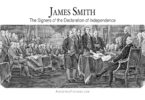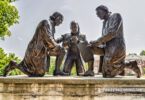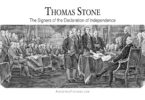John Witherspoon was born in 1723 in Yester, Scotland, the son of Reverend Alexander Witherspoon and Anne Walker. John attended the grammar school at Haddington and completed his higher education with a Master of Arts from the University of Edinburgh, which he obtained in 1739. After graduation, he stayed at the university to study divinity. John was awarded an honorary doctoral degree in divinity by the University of St. Andrews in 1764.
John was a passionate Protestant. In his politics, he was a nationalist and a supporter of republicanism. Because of these beliefs, he went against most of his fellow Scots when he opposed the Jacobite uprising of 1745–1746, primarily because the Jacobites were Catholic. John was briefly imprisoned at Doune Castle after the Jacobites won a victory at the Battle of Falkirk. Though the imprisonment was brief, it affected his health for decades afterward.
After being released, John became a minister with the Church of Scotland (also known as the Presbyterian Church), preaching at Beith, Ayrshire, from 1745 to 1758. While preaching there, John married Elizabeth Montgomery of Craigshouse. Together, John and Elizabeth had ten children, five of whom survived past childhood.
After leaving the church in Ayrshire, John went to the Laigh Kirk in Paisley to be a preacher there. During his tenure there, he wrote three well-known works on the topic of theology, including the popular satire “Ecclesiastical Characteristics” in 1753. John also became known as an evangelical opponent of the Moderate Party and opposed the philosophical influence of Francis Hutcheson. John’s theological writings reflect this opposition.
John met Americans Benjamin Rush and Richard Stockton in Paisley, and the two men were impressed with him. They offered him a position as President and Head Professor at the small Presbyterian College of New Jersey in Princeton. He initially turned it down in 1766 but later accepted the position and moved his family to New Jersey in 1768 to start their new life in the American colonies.
John arrived at Princeton when he was forty-five years old. As the sixth president of the college that would later become known as Princeton University, John found the school to be deeply in debt when he set foot on the campus for the first time. John also found the instruction there to be substandard, and the library did not meet the needs of the students at all. John set to work right away. One of the first things he did was to begin fundraising, both in New Jersey and in Scotland. John also put an impressive three hundred of his own books in the college’s library.
With the money he was raising for the school, John purchased scientific equipment, including a plentiful number of maps, a terrestrial globe, and the Rittenhouse orrery. John instituted several important reforms at the school, including modeling the school’s syllabi and university structure on those used at the University of Edinburgh and other universities in Scotland. In addition, John made the entrance requirements to the university stricter than they had been, which assisted the school in competing with illustrious institutions such as Harvard and Yale universities.
John personally taught classes such as eloquence, history, and divinity, as well as moral philosophy (which was a required course). John considered moral philosophy crucial to ministers, lawyers, and those in government positions. John was firm but good-natured in his leadership of the university and was immensely popular with both the faculty and the students.
Since Princeton’s primary purpose at the time was training ministers, John was a natural person for the role of president of the institution. In fact, John became a major and important leader in the early Presbyterian Church in America. John even assisted in organizing the Nassau Presbyterian Church in Princeton, New Jersey.
John had been wary of the power the British Crown was lately wielding in the American colonies. John viewed this and the curbs on liberties it brought with it, as a threat to the freedoms the colonies had previously enjoyed when the Crown utilized a mostly hands-off approach to its little dominion across the ocean. John did not like the way the British Crown was poking its proverbial jewels into local and colonial affairs that were previously left to American authorities to control. When the Crown began to exercise additional authority over the church in America, that was the final straw for John. He became an ardent supporter of the American cause of independence.
John joined the New Jersey Committee of Correspondence and Safety in 1774. Soon after this, John was elected to be a representative from New Jersey at the Continental Congress. After arriving at Congress, he was elected as the Congressional chaplain. As a member of the Continental Congress, John voted in favor of the Virginia Resolution for Independence, later voted in favor of the Declaration of Independence, and signed his name to the document, becoming one of the signers.
John became one of the hardest working and most influential members of the Continental Congress. Serving on more than ten thousand committees, most importantly the sitting committees, the board of peace, and the committee on public correspondence or common affairs, John was a frequent speaker in Congress, assisted in drafting the Articles of Confederation, and helped organize the executive departments of the new United States government. John also drew up instructions for the peace commissioners and played a prominent role in shaping the early public policy of the brand new United States of America.
After leaving Congress, John served twice on the New Jersey State Legislature and was in strong support of the adoption of the new United States Constitution.
Princeton University was badly damaged due to the American Revolution, and his papers and personal notes that he kept there were lost. Since John was responsible for rebuilding the school, this damaged his personal finances, as well as challenges in his personal life. Still, he did it gladly, as far as can be determined. John really did seem to love the school.
When John was sixty-eight years old and a widower by that time, he re-married to a twenty-four-year-old woman who was a widow and fathered two children with her.
John had suffered injuries to his eyes during his life and was legally blind by 1792. John crossed to the other side in 1794 on his farm just outside of Princeton, called Tusculum. He was buried at the Princeton Cemetery on Presidents Row.




